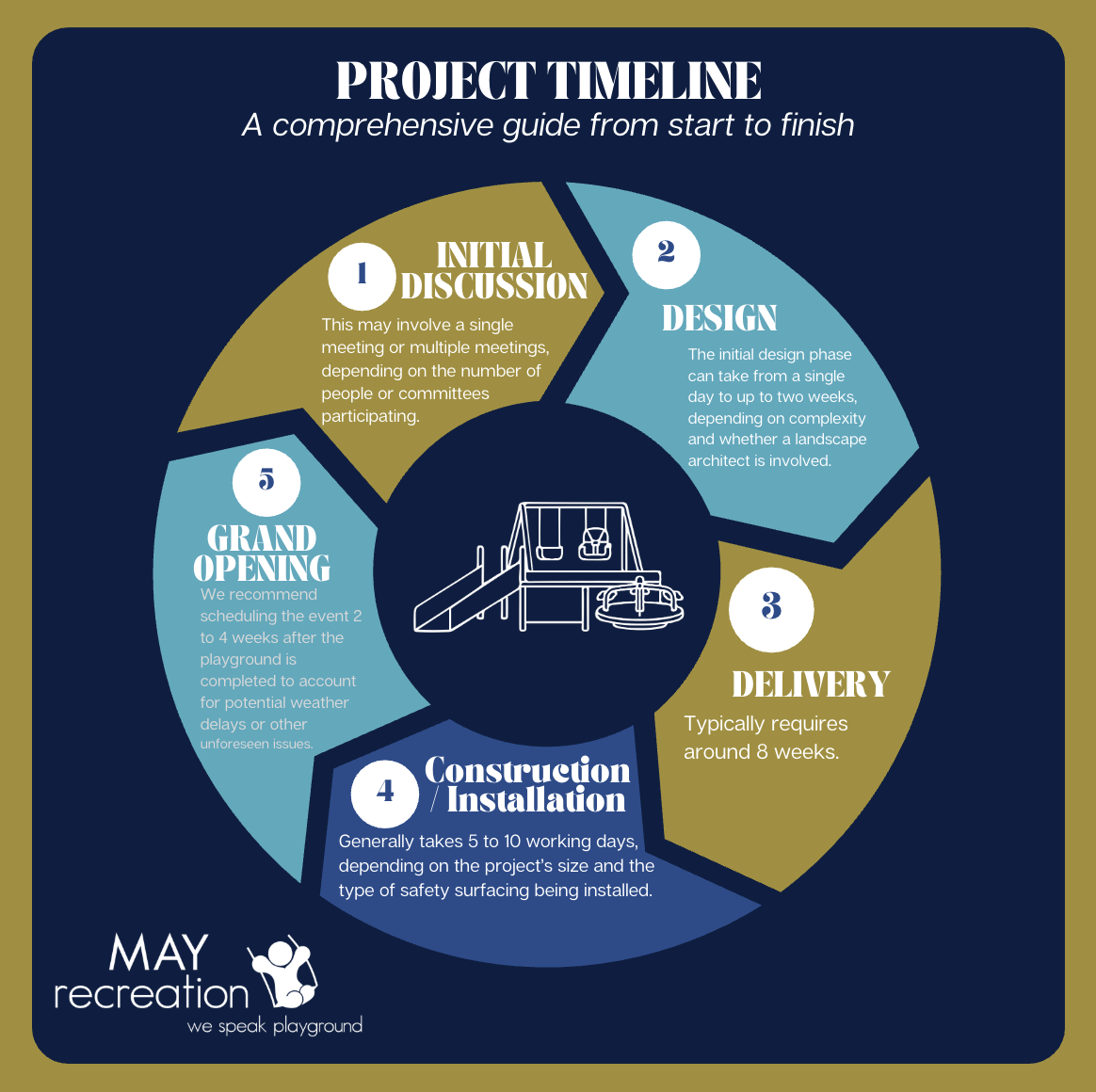Lifecycle, Cost, and Maintenance Planning for Outdoor Play Spaces
Posted by May Recreation Content Team on

It is not uncommon for city park directors, HOA board members, school leaders, PTA/PTO volunteers, and church administrators to all focus on one big thing when planning a new outdoor play space: How much will it cost to buy the equipment?
While knowing the upfront purchase price is important, it is just one part of the investment. The true financial impact of a playground extends well beyond installation, as ongoing maintenance, surfacing care, replacement, and safety updates drive long-term value.
When organizations look at the entire lifecycle instead of only the initial purchase, they’re better equipped to protect children, preserve budgets, and ensure their community enjoys safe and engaging play for years to come.
This is where smart playground lifecycle costing and maintenance planning come in.
The True Cost of a Playground
One of the most important facts for any owner or facility manager to understand is that the upfront equipment purchase price typically accounts for only 40 to 60 percent of your initial budget. The remainder comes from site preparation, installation, surfacing, amenities, inspections, and long-term care.
A commercial play space is more than just equipment. It’s a mini ecosystem of safety surfacing, hardware, shade, drainage, access routes, and ongoing upkeep. These elements vary widely in cost, but here are common industry ranges to help visualize how the investment breaks down.
While every project is different, most owners find that surfacing and installation represent a large portion of the investment, and the surfacing becomes a recurring cost as the playground ages.
Understanding this upfront helps avoid surprises later and allows budgets to stretch further.
Why Maintenance Planning Matters
Once a playground is installed, the work of protecting it has only just begun. Regular maintenance is what keeps equipment safe, surfaces in good condition, and kids protected from preventable injuries.
What Routine Maintenance Includes
A healthy playground maintenance plan incorporates:
- Routine inspections, including both monthly visual checks and annual comprehensive safety audits.
- Fastener tightening and replacement of worn or missing hardware.
- Cleaning and graffiti removal
- Lubrication or replacement of moving parts such as swings or spinners.
- Surfacing upkeep, which may include topping off engineered wood fiber, repairing worn turf areas, or patching poured-in-place (PIP) rubber.
- Drainage checks to prevent water pooling under surfacing.
- Recordkeeping for warranty compliance and safety tracking.
Most public or commercial play spaces require regular attention. In fact, deferred maintenance is one of the biggest contributors to premature equipment failure and one of the most common sources of preventable safety hazards.
The Hidden Costs of Deferred Maintenance
When maintenance gets pushed to “next season,” small problems often become large ones. For example:
- A loose bolt becomes structural damage.
- A small crack in PIP rubber becomes a large, expensive surfacing failure.
- Compacted engineered wood fiber loses impact attenuation, increasing fall injury risk.
- Faded, brittle plastic becomes unsafe or breaks entirely.
Emergency repairs are almost always more expensive than proactive maintenance. And when a playground must be closed unexpectedly, it impacts not only budgets but also the families and communities who rely on it.
This is why having a long-range maintenance schedule is just as important as choosing the right equipment.
Project Resources
At May Recreation, we know that building a playground is an investment, so we support our customers through the entire creation process. We provide helpful resources for each stage of the process and lay out a very easy project timeline.
Our resources include helpful information and tips for each stage of the process, including:
- Equipment
- Budgeting
- Surfacing Options
- ADAAG Compliance
- Site Selection
- Installation
- Maintenance

5 Tips for Planning the Full Lifecycle
A thoughtful maintenance plan helps facility managers extend the lifespan of their investment while staying ahead of safety requirements. The goal isn’t just to react; it’s to anticipate.
Here are practical strategies to help you plan for the full lifecycle of your outdoor play space.
Most experts recommend:
- Weekly visual inspections for high-use playgrounds like schools and city parks.
- Monthly or quarterly inspections for moderate-use play spaces.
- An annual comprehensive audit using ASTM and CPSC guidelines.
These inspections help you catch wear patterns early, track surfacing settlement, and identify potential hazards before they escalate.
-
Create a Multi-Year Replacement Plan
Some components, especially surfacing, have predictable lifespans. By planning 3 to 5 years, you can:
- Budget for PIP recaps or full turf replacements.
- Replace high-wear parts like swing chains and bearings before they fail.
- Refresh faded or worn areas to maintain curb appeal.
- Schedule work during seasons that minimize disruption for families.
-
Track Costs Year-Over-Year
Simple logs help you see long-term trends:
- Which components require the most replacement?
- Is a more durable surfacing option more cost-effective over 10 years?
- Are weather or drainage issues shortening equipment life?
These insights allow you to make smarter purchasing decisions in the future.
-
Review Playground Layouts for Safety Upgrades
Safety and accessibility standards evolve. Reviewing your playground periodically ensures compliance with current:
- ASTM safety standards
- ADA access guidelines
- Impact attenuation benchmarks for surfacing.
- Best practices around fall zones, transfer points, and guardrails.
A layout review every few years can reveal opportunities to enhance safety or improve usability for all children.
-
Work With Local Experts
Every region has unique considerations, from UV exposure and weather patterns to soil stability and local safety codes. Partnering with an experienced regional playground provider like May Recreation helps ensure:
- Accurate lifecycle forecasting.
- Recommendations suited to Texas heat, humidity, and storm patterns.
- Help to navigate warranty expectations.
- Access to high-quality replacement parts and surfacing options.
The right partner can make long-term planning far easier.
Budgeting for Replacement and Upgrades
The American Society for Testing and Materials (ASTM) has specific standards that require playground surfacing to be evaluated and replaced over time. The International Play Equipment Manufacturers Association follows ASTM standards when evaluating playground equipment for public use.
Surfacing Types and Lifespans
|
Surfacing Type |
Typical Lifespan |
Notes |
|
PIP Rubber |
8–12 years before recap; 12–15 years before full replacement |
UV and heavy use accelerate wear |
|
Engineered Wood Fiber (EWF) |
Top-offs 1–2 times per year; full refresh every 3–5 years |
Requires frequent raking and depth checks |
|
Synthetic Turf |
10–15 years |
Needs annual grooming |
|
Rubber Tiles |
10–15 years |
Individual tiles can be replaced as needed |
|
Rubber Mulch |
10–12 years |
Occasional top-offs |
Planning for these intervals, especially for large surface areas, ensures budgets remain predictable and aligned with real-world wear patterns.
Additional Upgrade Costs to Consider
- Shade fabric replacement: every 10–12 years
- New hardware and fasteners: every 3–7 years
- Repainting or powder-coating metal elements
- Adding inclusive elements, such as ramps, sensory features, or adaptive swings
- Annual/biannual safety audits and staff training
These upgrades help keep your play space welcoming, durable, and compliant.
Partner with May Recreation for Your Long-Term Investment
A playground is a long-term investment for your community, and a trusted partner like May Recreation can help you protect that investment.
By looking beyond the initial purchase and planning for maintenance, inspections, and eventual replacements, owners can stretch their budgets, enhance safety, and keep their play spaces vibrant for decades.
Smart lifecycle planning doesn’t just save money. It protects children, reduces downtime, and ensures your community continues to benefit from safe outdoor play.
Contact May Recreation today for a free consultation.
